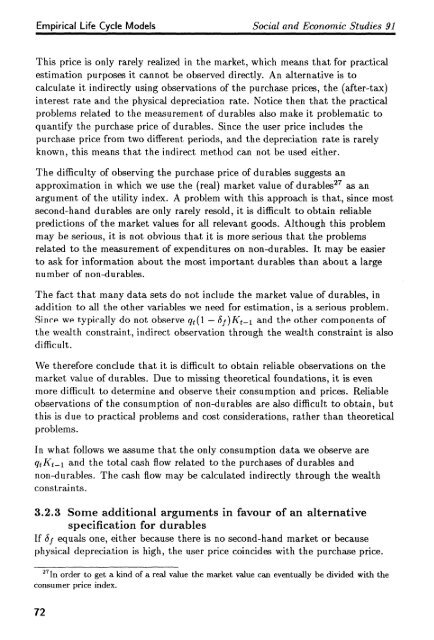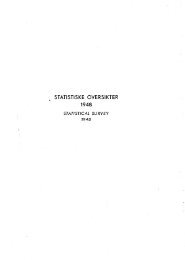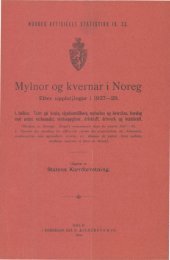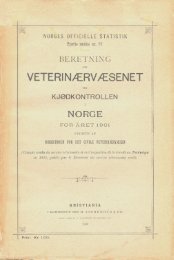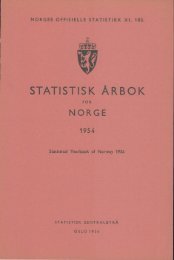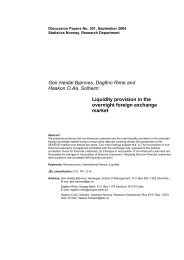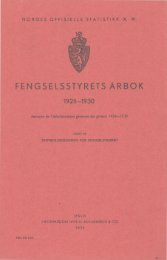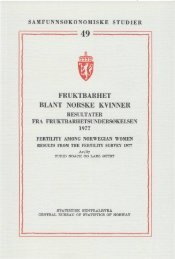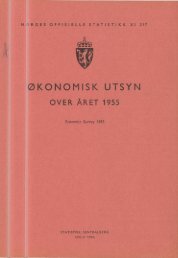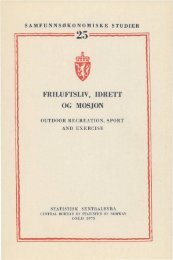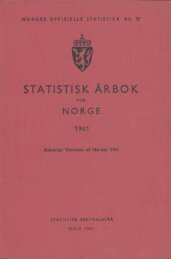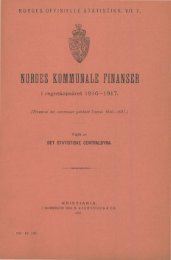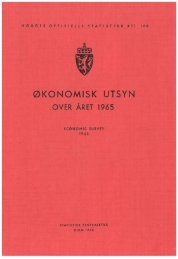Empirical life cycle models of labour supply and - Statistisk sentralbyrå
Empirical life cycle models of labour supply and - Statistisk sentralbyrå
Empirical life cycle models of labour supply and - Statistisk sentralbyrå
You also want an ePaper? Increase the reach of your titles
YUMPU automatically turns print PDFs into web optimized ePapers that Google loves.
<strong>Empirical</strong> Life Cycle Models Social <strong>and</strong> Economic Studies 91<br />
This price is only rarely realized in the market, which means that for practical<br />
estimation purposes it cannot be observed directly. An alternative is to<br />
calculate it indirectly using observations <strong>of</strong> the purchase prices, the (after-tax)<br />
interest rate <strong>and</strong> the physical depreciation rate. Notice then that the practical<br />
problems related to the measurement <strong>of</strong> durables also make it problematic to<br />
quantify the purchase price <strong>of</strong> durables. Since the user price includes the<br />
purchase price from two different periods, <strong>and</strong> the depreciation rate is rarely<br />
known, this means that the indirect method can not be used either.<br />
The difficulty <strong>of</strong> observing the purchase price <strong>of</strong> durables suggests an<br />
approximation in which we use the (real) market value <strong>of</strong> durables27 as an<br />
argument <strong>of</strong> the utility index. A problem with this approach is that, since most<br />
second-h<strong>and</strong> durables are only rarely resold, it is difficult to obtain reliable<br />
predictions <strong>of</strong> the market values for all relevant goods. Although this problem<br />
may be serious, it is not obvious that it is more serious that the problems<br />
related to the measurement <strong>of</strong> expenditures on non-durables. It may be easier<br />
to ask for information about the most important durables than about a large<br />
number <strong>of</strong> non-durables.<br />
The fact that many data sets do not include the market value <strong>of</strong> durables, in<br />
addition to all the other variables we need for estimation, is a serious problem.<br />
Since we typically do not observe qt (1 — 8f)Kt_ i <strong>and</strong> the other components <strong>of</strong><br />
the wealth constraint, indirect observation through the wealth constraint is also<br />
difficult.<br />
We therefore conclude that it is difficult to obtain reliable observations on the<br />
market value <strong>of</strong> durables. Due to missing theoretical foundations, it is even<br />
more difficult to determine <strong>and</strong> observe their consumption <strong>and</strong> prices. Reliable<br />
observations <strong>of</strong> the consumption <strong>of</strong> non-durables are also difficult to obtain, but<br />
this is due to practical problems <strong>and</strong> cost considerations, rather than theoretical<br />
problems.<br />
In what follows we assume that the only consumption data we observe are<br />
qtKt_ i <strong>and</strong> the total cash flow related to the purchases <strong>of</strong> durables <strong>and</strong><br />
non-durables. The cash flow may be calculated indirectly through the wealth<br />
constraints.<br />
3.2.3 Some additional arguments in favour <strong>of</strong> an alternative<br />
specification for durables<br />
If 6f equals one, either because there is no second-h<strong>and</strong> market or because<br />
physical depreciation is high, the user price coincides with the purchase price.<br />
27 In order to get a kind <strong>of</strong> a real value the market value can eventually be divided with the<br />
consumer price index.<br />
72


